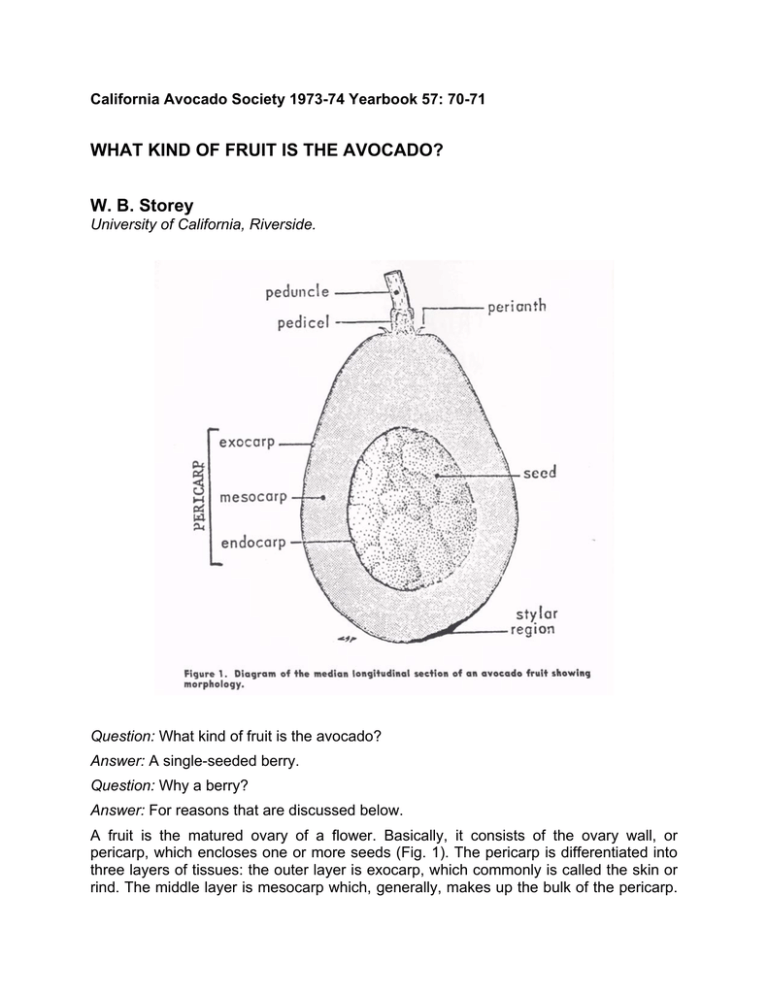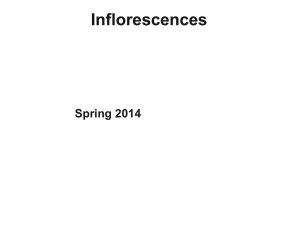WHAT KIND OF FRUIT IS THE AVOCADO? W. B. Storey
advertisement

California Avocado Society 1973-74 Yearbook 57: 70-71 WHAT KIND OF FRUIT IS THE AVOCADO? W. B. Storey University of California, Riverside. Question: What kind of fruit is the avocado? Answer: A single-seeded berry. Question: Why a berry? Answer: For reasons that are discussed below. A fruit is the matured ovary of a flower. Basically, it consists of the ovary wall, or pericarp, which encloses one or more seeds (Fig. 1). The pericarp is differentiated into three layers of tissues: the outer layer is exocarp, which commonly is called the skin or rind. The middle layer is mesocarp which, generally, makes up the bulk of the pericarp. The inner layer is endocarp which, in some fruits is tough, leathery or hard, in other fruits is soft or fleshy. In dicotyledonous plants, that is plants in which the embryo has two cotyledons or seed leaves, the seed consists of an embryo with the attached cotyledons, and two seed coats. The body of the embryo is differentiated into a plumule and a radicle. The plumule becomes the shoot of an emerging seedling, the radicle gives rise to the root system. The attached cotyledons serve as a reservoir of plant food for nourishing the young seedling until it can develop a root system. The inner seed coat is called a tegmen and the outer seed coat is called a testa. All fruits may be classified into two broad categories: dry, and fleshy. The avocado falls into the latter category. There are two main classes of fleshy fruits: drupes, and berries. Drupes are characterized by having a fleshy mesocarp but a tough-leathery or bony endocarp. They are said to have "stones" or "pits" rather than seeds. Also, a drupe usually has only a single seed. Berries, to the contrary, are characterized by having a fleshy endocarp, as well as mesocarp, and may have more than one seed. If one examines an avocado fruit cut longitudinally, as in Figure 1, he sees that the exocarp is the skin or rind. It may be very thin as in Mexican race avocados or thick and almost woody as in some of the large Guatemalan race fruits. The mesocarp is fleshy and makes up the bulk of the pericarp. The endocarp is thin, often not well differentiated from the mesocarp, and sometimes imperceptible. In some soft ripe avocados, it may adhere to the outer seed coat when the seed is removed from the fruit, giving the seed a sort of frosty appearance. The other labeled parts in Figure 1 are not pertinent to the discussion. The part labeled "peduncle" is a second, third, or fourth order branch of the flower cluster or panicle. The "pedicel" is the flower stalk. The term "perianth" refers to the sepals and petals of the flower that have persisted, and "stylar region" indicates the place where the now-fallen style of the flower arose. Now, if we go back to the introductory questions we can see why the answer to what kind of fruit is it? and why is it a berry? is: because it fits all the botanical criteria for that class of fruits.





